The vast world of science is filled with captivating stories waiting to be told.
If you’re a science enthusiast or a scientist with a knack for storytelling, why not create your own platform?
Now, you’re probably wondering, “But how do I start a science blog?”
Well, It’s easier than you might think, and this guide on how to start a science blog will walk you through the process.
Whether your fascination lies in the cosmos, nature’s intricacies, or the complexities of human biology, there’s an audience out there waiting to be inspired by your scientific insights.
Editors Note
This guide is extremely DETAILED and explains everything you need to start a science blog. I’ve been at this blogging stuff for over 8 years and have built a business making $20,000 per month, so I have a lot of helpful advice for you newbies out there.
If you get stuck or need advice, I HIGHLY recommend that you get my 100% FREE blogging course by clicking here. If that doesn’t help please contact me directly and I’ll help you out for free.
How to Start a Science Blog in 10 Steps:
If you just need someone to walk you through the process of setting up your blog quickly and easily, check out step 5.
According to the Pew Research Center, people employed in a STEM-related industry increased by 79% between 1990 and 2016, while employment in other industries grew by just 34%.

If you are interested in science and like to write, it may be time for you to start a science blog. Whether you’re a high school student and even one of the science lay readers, or a professional rocket scientist, there is more than enough room in the space for everyone and their insights.
Now, I know that building a blog may sound complicated. You’ll have to put together a website and find ways to reach your target audience of fellow science lovers. But I promise it’s not as hard as it might seem.
If you’re a computer scientist who loves to code, you can code your entire website with HTML and CSS. However, if you’re not a big coder, you can still build a fantastic website quickly and easily without writing a single line of code.
There are many reasons why someone might want to start a science blog. Below, I’ve listed some of the most commonly cited reasons:
- Let Your Voice Be Heard
- Build Your Resume
- Improve Your Writing Skills
- Learning How to Make Money in Science and Turning a Profit
- Educate Others
- Share Interesting Findings
- Get Noticed in the Science Community
Whatever your motivation, the steps below will help you build a strong foundation that will ensure the future success of your new science blog.
1. Decide on Your Focus for the Science Blog
Your first step in learning how to start a science blog is to decide on the focus of your new blog.
You must determine the direction your blog will take to guide your content creation and marketing efforts. It’s best to pick a niche you’re familiar with if you want to be successful with scientific blog writing.
Listed below are a few possible ways you can position your blog:
- Running and documenting experiments: This is an excellent example of a blog you can start if you are someone who enjoys conducting experiments. You can also start a blog focused on passing information to help researchers navigate professional waters.
- Discussing science news: This could be the ideal blog focus if you are gifted in writing epically insightful posts. Examples of blogs like these include Scientific American and Live Science.
- Reviewing interesting science case studies: Your blog can be focused on helping to use case studies to deepen scientific understanding. A great example of such a blog is NSTA.org.
- Innovation in the science blogging community: Are you good at taking the mystery out of equations? If so, you may be able to write posts that help level the playing field, particularly for those who are not even aware that there is such a monumental game.
These are just a few of the many different directions to take your new blog.
2. Choose Your Science Niche
This section will discuss the different types of science you can focus on with your blog. Take a look at each, and make your choice depending on what you are most knowledgeable, skilled, or experienced in and the area of science that inspires your passion.
- Oceanology: the study of oceans
- Zoology: the study of animals
- Astronomy: the study of stars
- Marine biology: the study of animals and plants that live in oceans
- Botany: the study of plants
- Geology: the study of minerals and rocks
- Physics: the study of force and motion
- Genetics: the study of DNA and heredity
- Physiology: the study of the way living things function
- Archaeology: the study of a past way of life
- Chemistry: the study of structures and chemical properties of substances
- Paleontology: the study of life in prehistoric times
- Entomology: the study of insects
- Biochemistry: the study of the chemical processes of living things
These are the branches of science you can choose from, but all these different areas fall into four basic categories: mathematics and logic, physical science, biological science, and social science. Keep in mind this list isn’t all-inclusive and you can always do something creative like the science of food, or the science of baking/cooking.
3. Choose Your Blogging Platform
There are tons of different blogging platforms for you to choose from. Some of them are free, and others are paid. The best platform for you to start your new blog will depend mostly on your goals for your blog.
For instance, if you’re happy to write posts and put in all the work to market your blog but never received any monetary return, a free blogging platform like Blogger, SquareSpace, or Wix might serve you well.
But, if you want to start a serious blog that you can monetize and make a real income from, I recommend you use a self-hosted WordPress platform instead of a free one.
WordPress is one of the best blogging platforms available today, and many advantages come from choosing self-hosted WordPress for your blogging needs.
- WordPress is user friendly and makes it easy for beginners to get started
- You can install it in one click
- You have complete control of your web domain and content
- Search engines love self-hosted WordPress websites as they are superfast for Search Engine Optimization
- You can monetize your WordPress website in a variety of ways
- Any time you face issues or have questions, there is ample technical support
- You can customize your science blog to look any way you want
- There are tons of plugins you can use to extend your website’s functionality
These are just a few of the many benefits you get with WordPress – The majority of which you do not get with free, hosted websites like the ones mentioned above.
The platform is also secure, customizable, and flexible, making it the absolute best choice for starting your new science blog.
Furthermore, you get a professional-looking domain name that doesn’t have the host’s name tacked on to yours, as in: MyAwesomeScienceBlog (dot) com vs. MyAwesomeScienceBlog.SquareSpace (dot)com
Still not convinced? Check out these recent WordPress stats:
- Over 39.6% of website owners and bloggers online use WordPress. This is an impressive 4% rise from 2020!
- WordPress websites receive over 400 million visitors each month.
- Almost a third of all eCommerce goes through WordPress (WooCommerce).
- An average of 661 WordPress websites are created each day.
- There are over 50,000 free and paid plugins and themes on offer on WordPress
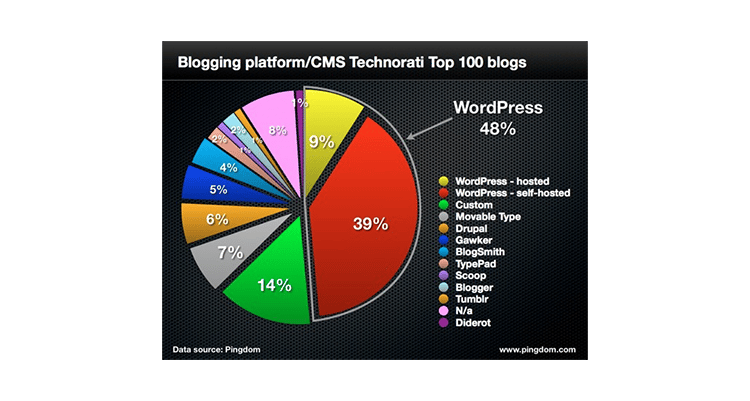
As you can see, there are many reasons why you should choose WordPress for scientific blog writing.
4. Decide on Your Domain Name
Now that you’ve chosen your blogging platform, it’s time for the next step on how to start a science blog – deciding what you will call it.
The domain name is your new blog’s address on the internet. Although it can be different from what you call your WordPress blog, it’s good to keep the blog name and domain name the same to avoid confusing your visitors.
If you conduct a quick search online from search engines, you will find an endless list of how to choose the perfect name, but the process is straightforward:
1. Use “.com”: These days, there are a lot of science-related domain extensions, including .science, but it’s always a good idea to stick to .com extensions as these have been shown to build trust with users.
2. Opt for a Broad Name: Avoid using a too narrowly focused name on your topic, such as “Gravity Experiments for Kids,” as this will limit the type of content you can create. Over time, it will also be harder for you to grow your blog. Instead, choose a broader name, such as “FunPhysicsExperiments” to give yourself space to expand your science blog.
3. Keep It Short and Sweet: Make sure the name you choose is short and easy to type into the browser. Stay away from long, complex words, and keep your science blog name to two words. If necessary, you can use three or four words, but do your best not exceed that number.
These are just the top three tips to help you choose the best name for your new blog.
Keep in mind that this should be a reasonably fast decision. There is no need to spend more than a couple of hours on this task. So set aside the required time and follow the steps outlined in the guide.
Examples of Some of the Best Science Blogs (and why their Science Writing names make sense)
1. Improbable Research: This name is simple and easy to remember. Also, it makes it clear at a glance what type of science blog this is.
2. Space (dot) com: This is another example of a simple name describing the blog’s focus. This blog provides news on space exploration, NASA, and astronomy.
3. Science Alert: This blog provides all the latest news in the science world. Again, the name is simple to remember and type into the browser.
4. Starts with a Bang: This science blog is all about helping people discover the wonders of the universe, something that can easily be deduced from its playful name.
5. Science Sparks: This kids science blog uses alliteration to create a name that is unique and easy to remember.
5. Buy Your Domain Name and Hosting
As part of learning how to start a science blog, you’ll have to purchase a domain name and your favorite website hosting service.
As previously stated, your domain name is like your blog’s address on the internet. The hosting is the real estate on which you will build your online home (that is, the website where your science blog will live). Some of the best science blogs have catchy domain names while others are either plays on words, exact definition of what the blog is about, etc.
Below is a step-by-step tutorial where I walk you through the whole process of buying your domain name and hosting.
Step 1: If you haven’t yet, click on this link, and you’ll be brought to the WordPress Hosting page that you see below.

Step 2: Next, you’ll be brought to the hosting plan page. You could choose to get a “Plus” or “Choice Plus” plan, but that’s not a requirement.
The Startup plan is the cheapest at $2.95/month through my link vs. the normal $8.99/month.
This plan has everything you need including 50GB of webspace (plenty of room for your files), a free domain for a year, plus other standard features like a free SSL and a secure WordPress install. Feel free to browse a bit to decide on the right plan, but rest assured that Basic will work just fine if you want to minimize your investment.
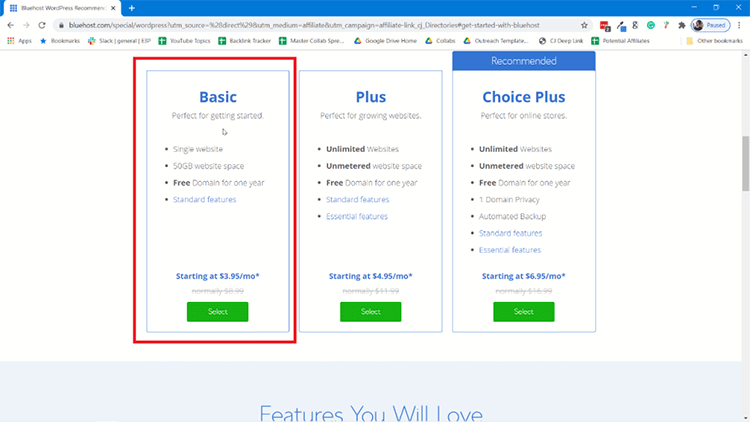
Step 3: After clicking on the plan, you’ll be brought to the next page where you will type in your new domain, or you can choose “I’ll create my domain later” if you haven’t decided on one yet. The domain is the URL people will type into a browser to view your website in the future.
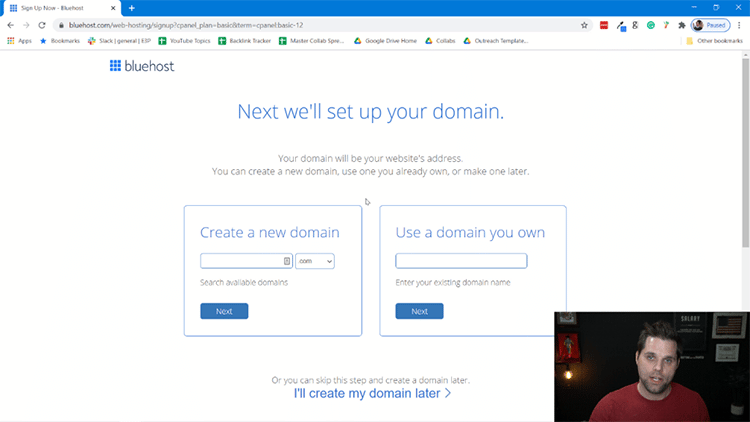
Step 4: Once you submit, the next page will ask for all of your information. That will start with your account information, which is self-explanatory.
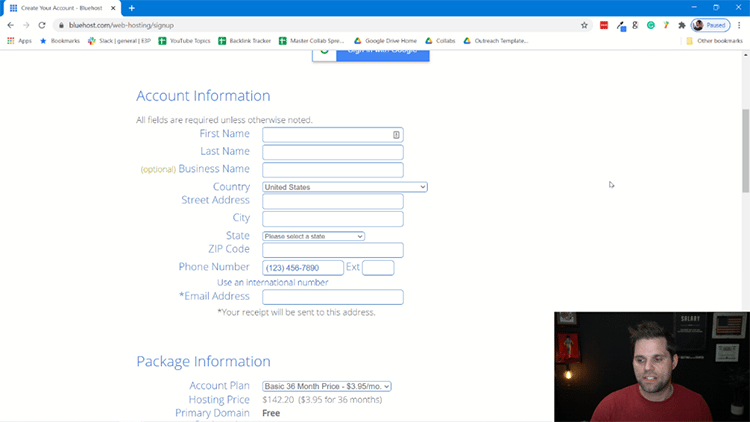
Step 5: Next, you’ll have to input your Package Information. This is to choose how long you want the plan to go. I advise you to choose 24 months to get the discount and save some money, but you can go as low as 12 months.
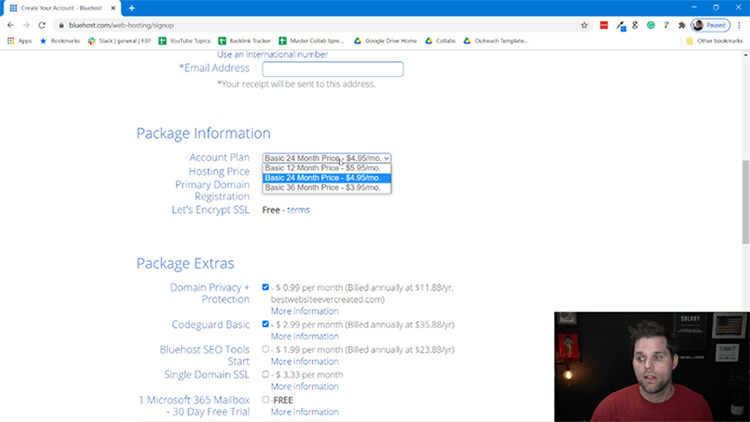
Step 6: Next, you’ll have to choose what “Package Extras” you want. You can scroll over “More Information” to understand each of these items, but here is my advice.
I would get the “Domain Privacy + Protection.” This makes it so that no one can tie your name to the domain name you create. The only other one worth considering is “Codeguard Basic.” The other two I wouldn’t personally get. But choose what is best for you.
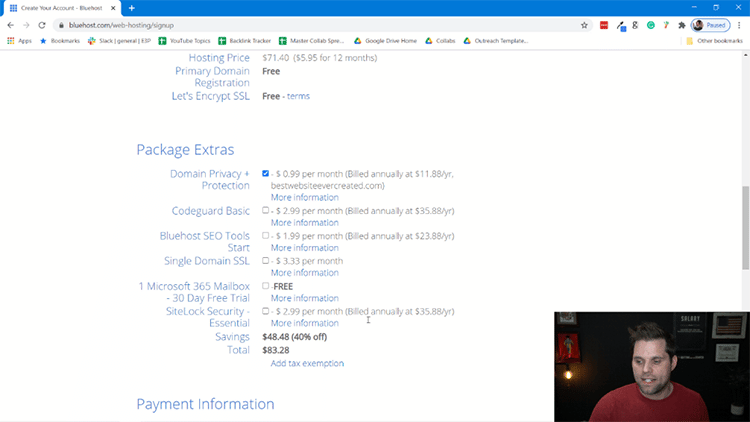
Step 7: The next step is Payment Information, which is self-explanatory.
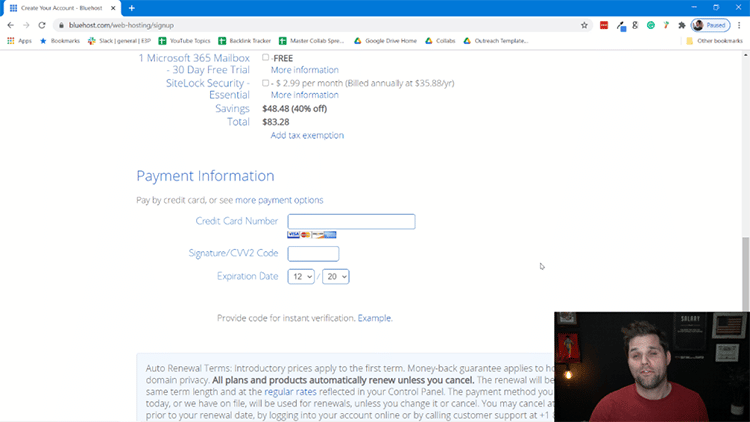
Step 8: The last step of signup is to confirm that you read and understand the Bluehost Terms of Service, Cancellation Policy, and Privacy Notice. Click the check button and then click “Submit.”
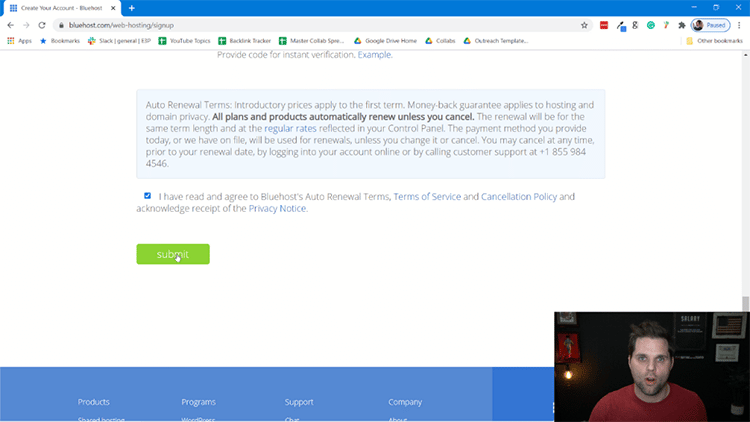
Step 9: Next, you’ll be prompted to create an account and password. You’ll use this information to log in to the Bluehost platform to manage your site and account info.
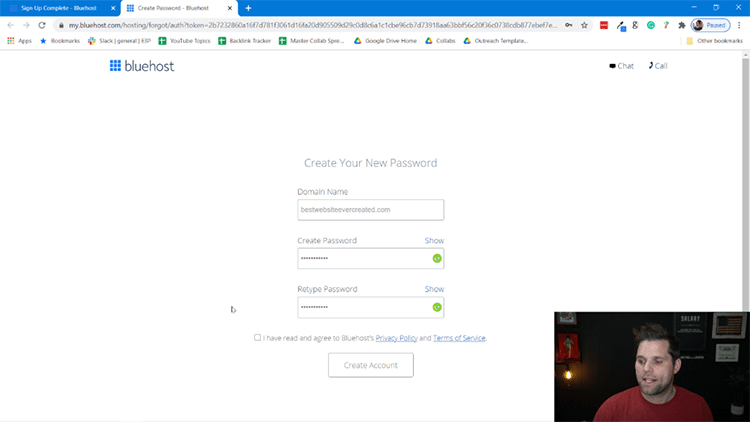
Step 10: At this point, Bluehost puts you through a short questionnaire to better understand your scenario. You can answer all of these questions or click “Skip this Step” at the bottom. If you’re a newbie, I advise you to answer the questions as it’ll help your onboarding experience.
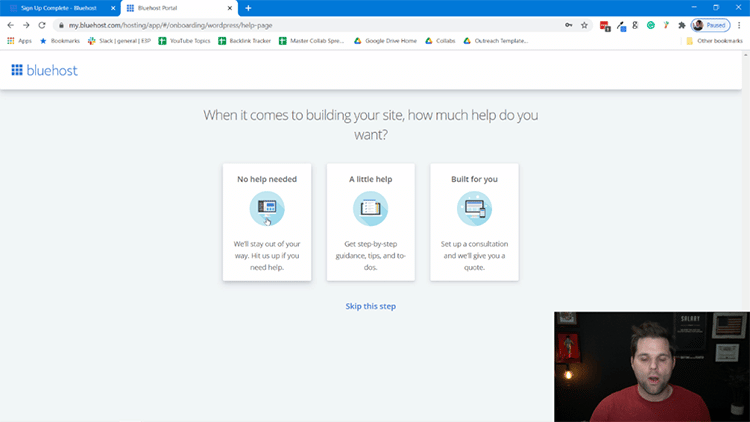
Step 11: After you’re done with that, you’ll be advised to choose a theme. For now, you can choose to use a free theme. But, of course, you can always replace the theme later if you’d like.
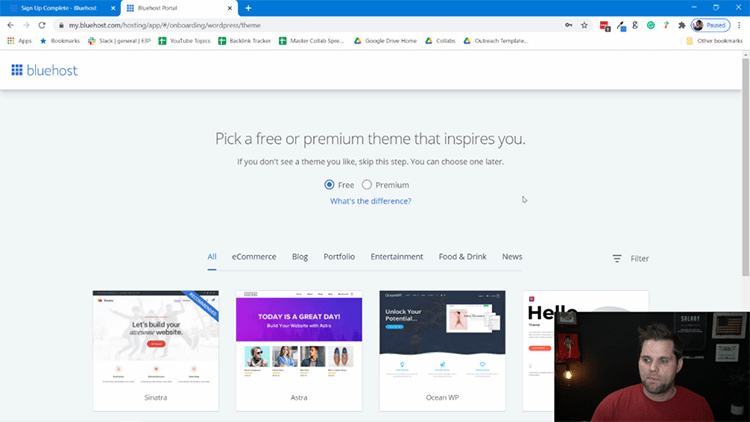
Step 12: You’ll be brought into the backend of WordPress in the admin panel. This is where you’ll manage your site from. You can add posts/pages as you see fit, but when you’re ready, click on the blue button that says “Launch Your Site.”
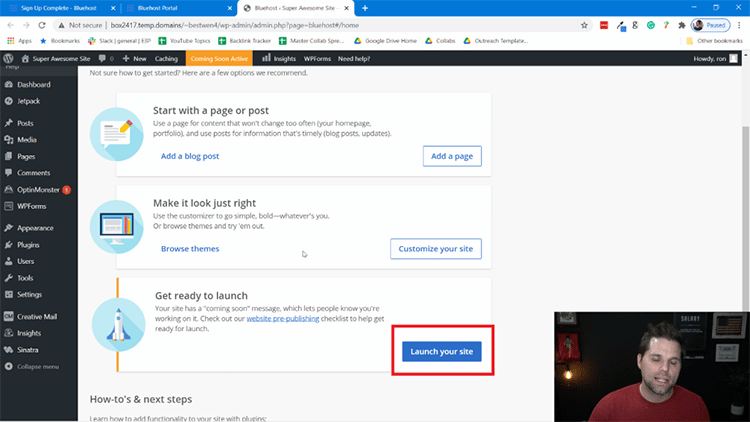
Step 13 (Final): Your blog is LIVE. Just go to a browser and type in your domain name. Once you do this, you’ll be able to access your website!
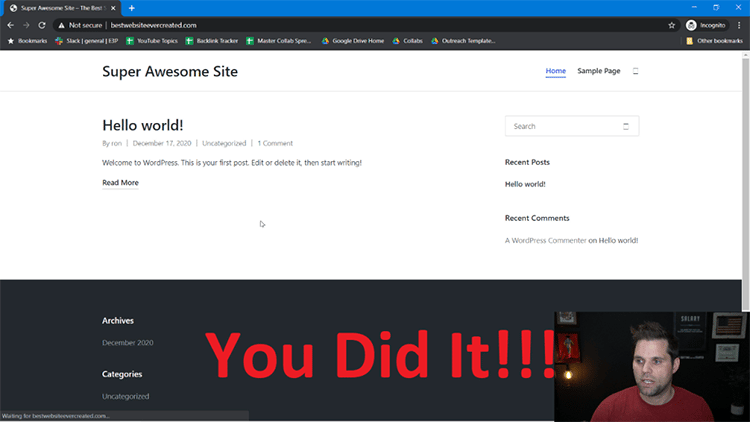
Congrats! You officially have a website.
If you’re wondering how to edit things on the website, all you have to do from here is go to your website URL with /wp-admin at the end in a browser and log in.
Example: http://mostawesomewebsiteever (dot) com/wp-admin
And don’t worry, we cover how to edit things more in the rest of this guide. So please continue reading.
6. Choose and Install a Theme For Your Science Blog
Now that you have your hosting and domain names taken care of, it’s time to start building your website, and the first thing to do is choose and install a theme.
A theme is simply software that will dictate how your blog looks. In keeping with the analogy above, your theme can be likened to the interior decoration of your home.
As with most other online tools and software, there are tons of themes to choose from, both free and paid. It’s crucial to choose a good-looking theme designed to attract your ideal visitors to your blog and help you maintain engagement and boost conversions.
Free themes will not help you achieve this, which is why it’s always best to opt for a premium WordPress theme, such as the ones below:
What to Look For in a Good Theme:
- Responsive to all devices
- Speed
- Reliable Support
- Beautiful Designs
- Customization Features
- Well-known Brand
- Positive Reviews and Ratings
Science Blog Theme Options for WordPress
- Divi: If you’re looking to design a stunning website with ease, Divi from Elegant Themes stands out as arguably the best WordPress builder available today. Its intuitive visual drag-and-drop interface empowers users to craft amazing sites quickly. What sets Divi apart is its vast array of customizable modules, real-time design feedback, and a responsive editing feature that ensures your website looks impeccable on any device.
- Astra: While Divi is renowned for its versatile design capabilities, the Astra theme offers a distinct set of advantages for those prioritizing speed, performance, and seamless integration. Astra stands out for its feather-light weight, ensuring that websites load at lightning-fast speeds—a critical factor for SEO and user experience. Moreover, Astra’s deep compatibility with major page builders, including Elementor and Beaver Builder, means that users aren’t restricted to a single design environment. The theme is also built with a focus on customization as well. You can read my Astra Theme Review if you want to learn more.
- Themeforest.net: Themeforest has a significant amount of themes far beyond other platforms out there. There are over 48,000 total themes available on this platform, so you can find whatever you need.
Bridge – Creative Multipurpose WordPress Theme

This theme is excellent for anyone who wants to build a portfolio website for a scientific company or similar endeavor. It’s effective and powerful and comes with over 350 demos, each of which is ready to use so you can hit the ground blogging.
BeTheme WordPress Science Blog Theme

This is an excellent theme for working with a science company website. It is feature-rich, easy-to-use, and comes with over 400 pre-built templates. This means you can create a high-quality, professional-looking science blog without ever learning a line of code.
Zeen – Next Generation Magazine WordPress Theme

Zeen is a popular news and magazine theme perfect for science blogs. It’s designed for easy use, which means bloggers of all skill levels can quickly master it. With it, you will be able to create a beautiful, highly-unique science blog and even integrate a full-blown WooCommerce shop.
Independent – Multipurpose Blog & Magazine Theme

This clean, multipurpose theme will help you create a unique, high-quality science blog. It’s responsive on all devices and comes with many pre-built templates to make it easy for you to get your new science blog up and running.
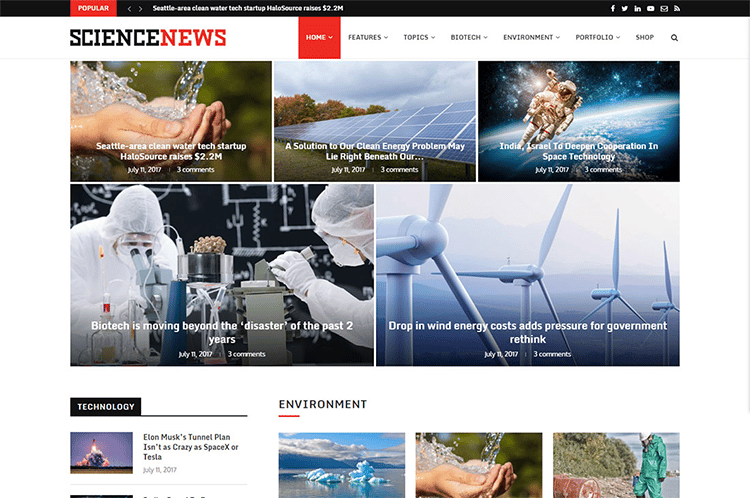
This multi-concept WordPress theme has over 5,000 homepage demos to choose from. This means you will have no problem finding exactly the type of layout and design that appeals to you and your target audience.
7. Create Essential Pages & Logo
Now that your theme has been installed, you can start creating your website’s logo and essential pages. I’ve listed the three main pages you need to create below. Science blogging can be tedious in the beginning because there’s a lot of preparation going on but it’s necessary.
Of course, depending on the type of blog you have, there may be other pages you need to add, such as a product page, resource page, etc., but these are the essential pages that you must create first.
About Page: The About page is among the most important (and most visited) pages on a website. This is prime real estate, and it’s important to take the time to ensure that the page is optimized in every way.
For instance, when readers come to this page, they want to know you, so make sure you tell them who you are, what you do, and why you do what you do.
Clearly explain what they will gain by reading your blog. And don’t be afraid to let your personality shine through, as this will make it easier for your readers to relate to you. You can also include a photo of yourself on this page, so people know who they’re talking to.
Contact Page: All science blogs need a contact page with all the relevant information so readers can get in touch with you quickly. You can also add a professional contact form to the page using a plug-in like Contact Form 7 for WordPress blogs.
Include other information on this page, such as your email address, Skype address, physical address, phone number, etc., depending on what’s most convenient for you and your readers.
Privacy Policy: Your science blog needs a Privacy Policy page, as well as other legal pages, such as Terms of Service, Disclaimer, etc. There are places online where you can get a free Privacy Policy, and you can also enlist the help of a qualified professional to make sure you’re complying with the privacy laws in your area.
Check out my list of privacy policy generators for free and paid options to help.
Create a Logo: Your logo is important for various reasons, mainly because it will help the general audience recognize your brand. You can use one of these logo generator platforms to create a high-quality, professional-looking logo to represent you and your brand.
8. Begin Blogging
Now that everything is set up, it’s time to start writing and blogging your first post. Whether you are catering to students, the public, academia granting agencies, or anyone, you need to create high-quality, unique, and good science writing on a regular basis.
Additionally, you need to know your particular focus so you can determine the best method of science communication and writing. For example, discussing and writing about green technology will require a very different type of content and style than writing about string theory.
If you’re a researcher or scholar, then it may be best to focus on your own research and discuss your recently published paper, and even do writing projects for your ideas for papers and articles.
You can simplify and write scientific papers so that lay folks can understand the complex scientific material. It’s always best to show off your expertise and write short scientific papers to your readership to gain followers when you also write good headlines such as descriptive headlines for research topics and start blogging.
If you’re not a researcher, it may be best to peruse a few ideas before deciding on what category you want to focus on. One of the best ways to determine the particular focus of your science blog is by breaking down your main science topic into different categories. You can then write posts and articles on a variety of topics under each category using right keywords for your blogs.
For instance, if you choose “environmental and health science” as the main focus of your soon-to-be successful blog, your categories could be any of the following:
- Oceanography, Arctic Science
- Geography, Geology
- Seismology, Meteorology
- Hydrology, Glaciology
- Natural Resources
- Climate Science
- Green Tech
- Sustainable Development
- Renewable Energy
Of course, there are many other categories you can write on. To find more resources about the different blog categories for all the major branches of science, you can check out this article.
Once you’ve decided on the main category or categories of your blog, it’s time to write your first blog post.
Important Note: Make sure you have at least 10 posts written before you start promoting your new science blog so that your visitors land on a professional-looking blog that is populated with enough content to stimulate their interests and encourage them to return to your blog to read more posts.
Over time, you’ll learn how to write a science blog in a more efficient manner, especially by analyzing what others are doing.
9. Promoting Your Science Blog
The second to last step in learning how to start a science blog is understanding how to promote it. Even if you have the best content on the web, you’re still going to need to engage in outreach in order to build a following and gain subscribers.
There are tons of different ways you can use to promote your new science blog. I’ve listed a few below:
Tell Your Friends and Family
As soon as your blog is live, you need to tell all your friends and family about it. Ask them to come to your blog, read your posts, and share your blog with others. They can also provide you with a lot of helpful feedback on your post directly and on ways to improve your blog so you can make a big impression on your audience.
Personal Communication, Online, and Social Media Accounts
Social Media: Social media accounts are yet another powerful way to promote your blog. It is one of the best huge traffic drivers for your blog from non-scientists to lay readers. If you are already active on the different social sites, simply share the link to your blog and post across all of your established social media accounts including Facebook, Twitter, Tumblr, LinkedIn, and many others.
If you’re using your own high-quality images, you could even share those on Flickr. There are also many services on the web to help you automate sharing across multiple social media platforms quickly and easily.
Relevant Forums and Groups: Joining relevant groups and forums online is yet another great way to promote your new science blog to a wider audience. Just remember to lead with value instead of spamming the groups or forums with your blog link.
Guest Blogging with other Science Bloggers: Find other popular blogs in your niche. and offer to write content for them as guest bloggers. Writing guest posts on other blogs and other science bloggers will open you up to a whole new audience who will then follow you back to your own blog.
Join a Science Blogging Network: Beyond guest posting, you can also join a science blog network where you, as a budding science writer keen to build and increase your reputation within the science blogosphere.
This will help you expand your reach and increase social capital while sharing links between your blog and others within the blog networks. You can also communicate with potential collaborators and potential employers. Link-building collaborations can be very helpful for increasing the ranking and authority of your blog.
Create a Podcast: You can also create engaging podcasts which you then post on your blog. These podcasts are very helpful because they diversify your content and open up the door for you to interview and meet other scientists and science bloggers.
Yet another great tip for promoting your blog is to look at the techniques used by your competitors. Pay attention to the different methods they use to promote their blogs and see what will work for you and your audience.
10. Start Making Money
Now comes the fun part – learning how to make money in science (as a science blogger). Science blogging can be highly profitable if you pick the right avenues for turning a profit.
Here is a list of a few different ways you can monetize your science blog and start earning an income from your audience.
Affiliate Marketing: As a science blogger, you can get paid for recommending relevant products and services to your audience. All you have to do is write high-quality posts on your science blog and include your affiliate links. Each time a reader clicks a link and makes a purchase, you’ll be paid a commission.
Consulting: You can offer your consulting services, one-on-one coaching, etc., on your blog as a way to monetize it from the start. This monetization method is great because it doesn’t require that you have a large following for it to work.
Information Products: You can help investors get more exposure, offer science lessons or even create products that help people with their education – the list goes on.
Display Ads: Sign up with an ad network like Google Adsense or one of their alternatives so you can get paid for showing ads to your website visitors.
Selling Your Own Products: As a science blogger, you can create your own products, such as science kits for kids, etc., and sell them on your blog.
Sponsored Posts: As you start to make a name for yourself in your niche, you can work with brands in the science industry and get paid to write sponsored posts on your blog.
As you can see, there are tons of different ways to make money with your new blog. Check out this post that goes into even more detail on how you can make up to $25,000 per month blogging. Once you’re done learning how to write a science blog properly, there’s no doubt you’ll start making money.
How to Start a Science Blog: The Final Word
Now you have within reach everything you need to begin your science blogging adventure.
If you follow these steps and do your best to go through each part of the process, you’ll see some level of success and can email me to tell me how great it is. (Kidding, but really…)

Thanks for this great write-up. I have been worried about starting a biomedical blog, but you’ve just given me enough confidence that I can make something of blogging.
💪💪✌✌✌
Glad it helped!
Thank you Sir. This is very helpful to start creating my Science blog.